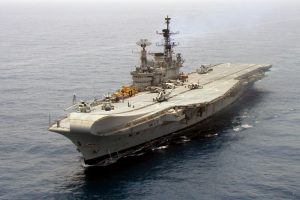Is INS Viraat finally headed for the shipbreakers? Reports early last month indicated that the time of the storied aircraft carrier had nearly come to an end after the failure of several preservation efforts. As of the end of September, the ship was prepared for scrapping. However, a last ditch effort still hopes to preserve Viraat as a museum and tourist attraction.
Viraat began life as Centaur-class carrier dubbed HMS Hermes, part of the the British Royal Navy’s mid-war building program that also spawned the Colossus-class light carriers and the Audacious-class fleet carriers. These ships were intended for eventual use in the Pacific, where they would form the core of a fleet that could destroy the remains of the Imperial Japanese Navy. The end of World War II reduced the projected number of Centaurs from eight to four, and delayed the construction even of the ships that were not cancelled. Hermes, fourth in the class, was laid down in 1944 but not completed until 1959.
In 25 years of service with the Royal Navy, Hermes performed numerous duties from strike carrier to anti-submarine warfare to amphibious assault. The ship achieved its greatest fame during the Falklands War, when it anchored the Royal Navy task force that enabled Britain to recapture the islands following their seizure by Argentina. Operating Sea Harriers, Hermes provided cover over the expeditionary force that eventually landed and retook the islands.
Hermes was decommissioned in 1984. The prospect of a sale to Australia seemed promising, but the Australian government eventually decided to forego modernization of its naval aviation capability. In 1986 India stepped in and acquired the carrier as a replacement for INS Vikrant, a former Majestic-class aircraft carrier that had served in the Indian Navy since 1961. Viraat served as India’s primary carrier until 2015, when it was replaced by the Russian-built INS Vikramaditya.
Since decommissioning, various groups have made efforts to preserve the aging ship. Vikrant, her predecessor, was converted into a hotel after decommissioning in 1997, but the hull was insufficiently maintained and was declared unsafe for the public in 2012. Subsequent efforts to raise enough money to repair the ship failed, and it was scrapped. A similar fate seems likely to befall Viraat, following the failure of campaigns to raise funds in both India and the United Kingdom. Last month, it was transferred to Alang and beached in preparation for dismantlement.
However, the Goa government has staged a last-minute intervention in an effort to save the ship. The government of Goa contacted the shipbreaking firm before significant scrapping efforts began, and appears to be in negotiations over the possibility of a sale. Prospects for preservation seem grim, however, as the Indian Ministry of Defense has assessed the hull to be in critical condition. The beaching of the ship in anticipation of scrapping may have caused additional damage.
Hermes-Viraat is a truly historic ship, spanning the history of naval architecture from World War II until the jet age, and playing a crucial role in one of the most iconic naval conflicts of the second half of the 20th century. The ship also served as the foundation of Indian naval power for over a quarter century. In ideal circumstances, her preservation would be well-merited and deserving of strong consideration. In context of a pandemic and the immediate national security threats faced by India, however, it seems unlikely that it can be saved for future generations.

































